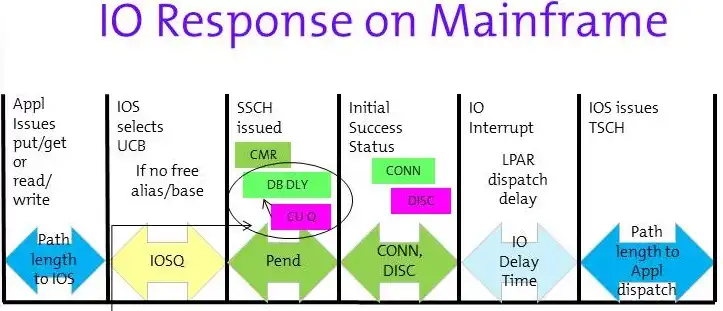IBM APAR OA39993 available for the zEC12 processor introduced what could be considered a new Service Time component for devices, Interrupt Delay Time. This value measures the time from when the IO completes to when the z/OS issues Test SubChannel (TSCH) to view the results.
Not new, but previously Uncaptured
I selected the title for this Blog as “nil sub sole novum”. It’s a common Latin phrase whose literal translation is ‘Nothing under the Sun is new’, meaning ‘everything has been done before’. This is very true for Interrupt Delay Time, the component is new but the activity has always been with us. This activity was previously without description. It came from what you could call ‘Uncaptured IO Time’. Even my spell checker rebels against the use of the word uncaptured.
The Anatomy of an IO
Uncaptured time in the processor is a familiar statistic. Uncaptured IO Time is the discrepancy between what RMF would report response time to be and what an application (like CICS) could measure for response time for the same IO. In the above chart, the two arrowed labels containing the word ‘Path’ are still uncaptured IO time (slots 1 and 6).
Uncaptured IO time now Captured
So Interrupt Delay Time (or IO Delay Time) is a measure of IO Elongation (the fifth slot from the left in the picture above). If high values are presented in this field, the possible causes might be a non-Dispatched LPAR or the lack of an interrupt enabled CP.
Conclusion
Support for tracking Interrupt Delay Time is provided in IntelliMagic Vision Version 7. By default, Warning and Exception Flags are raised in IntelliMagic Vision when Interrupt Delay times are >.3 and >.6 milliseconds, respectively. The expected value of this component is less than 0.1 milliseconds. Should this value become troublesome because of LPAR Dispatch Delay, a more aggressive value can be used for CPENABLE parameter in the IEAOPTxx parmlib member by changing it from the default value of (10,30) to something like (15,20).
Breaking out the Interrupt Delay Time from the uncaptured IO time is first possible on the IBM zEC12/zBC12 processors and applies to any vendor’s storage equipment. I think we can all agree that Interrupt Delay Time is a timely addition as we embrace sub-millisecond response time reporting.
This article's author
Share this blog
Related Resources
IntelliMagic Vision Support for Hitachi VSP SMF Records from Mainframe Analytics Recorder
Learn how to gain insight into the health of the Hitachi Virtual Storage Platforms VSP 5000 series and VSP F/G1x00 storage systems using the SMF records created by the Hitachi Mainframe Analytics Recorder.
From Taped Walls to Your PC: z/OS Configuration Made Simple with Topology | IntelliMagic zAcademy
In this webinar, we explore a technique that integrates diverse data sources from z/OS, presenting them in a clear, concise, and interactive visual format.
Banco do Brasil Ensures Availability for Billions of Daily Transactions with IntelliMagic Vision
Discover how Banco do Brasil enhanced its performance and capacity management with IntelliMagic Vision, proactively avoiding disruptions and improving cross-team collaboration.
Book a Demo or Connect With an Expert
Discuss your technical or sales-related questions with our mainframe experts today


 Dave Heggen
Dave Heggen